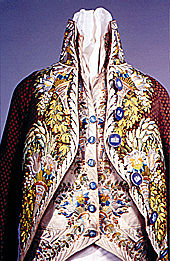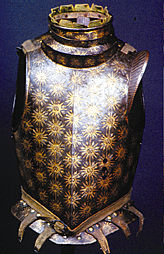
The exhibition opens with two sixteenth century armed figures - an Ottoman and a European - standing opposite each other. The former wears a cuirass that is more like a metalized dress formed of a few pieces of flexible and two-dimensional chain mail; the latter is completely enclosed within a distorted and unnaturally shaped war machine, composed of numerous three-dimensional and sculptoreal elements, linked together with extremely complicated mechanisms. European clothing, characterized by tailored lines obtained with stiffening, padding, boning and clever cutting, is derived from this idea of the armour-covered body and the virile ideal of the eternally warlike male. This explains the development of the West's unique standards for clothing which was thus created with a large number of segments. On the other hand, two-dimensional, flexible, unitarian and shapeless clothes are typical of what is worn by various Islamic peoples living from North Africa to the Caucasus.

All the exhibits on display in the exhibition form part of one of the most important collections of costumes, weapons and armour in the world which belongs to the Stibbert Museum, founded by Frederick Stibbert, a brilliant Englishman who lived in Florence and who, on his death, left the wonderful collection that we can admire today to the city. His house and the museum he created still reflect the romantic yet nostalgic atmosphere that was so typical of the second half of the nineteenth century. The exhibition itself has been set up in the recently restored new rooms in the North Wing of the Museum, now fully equipped with the various facilities that are essential for a modern and functional museum.
Dress for the Body, Body for
the Dress
Stibbert Museum. Until April 30th 1999
